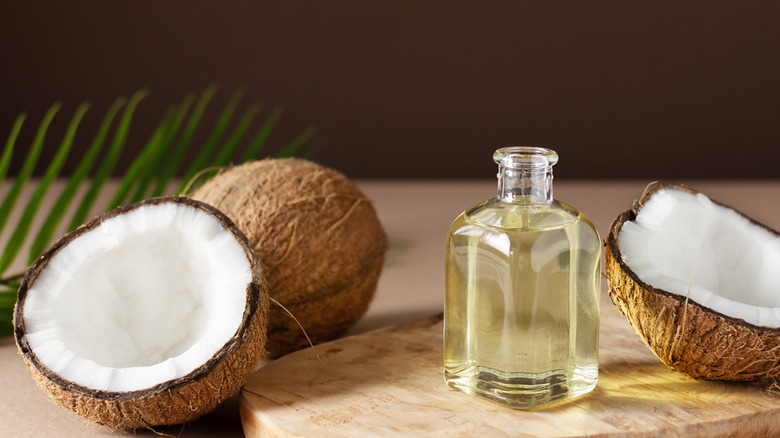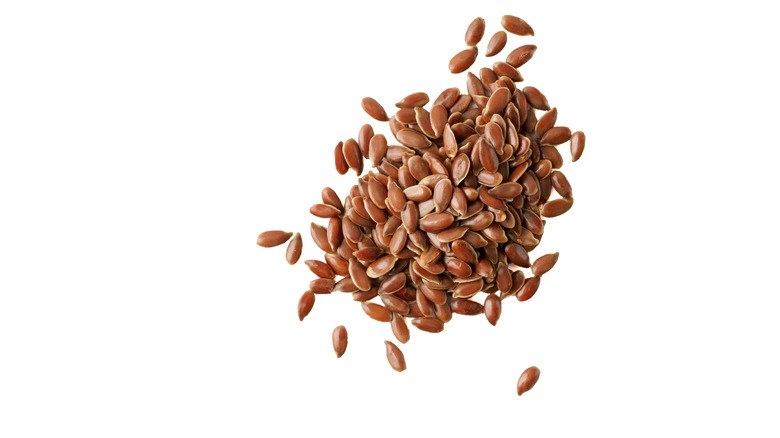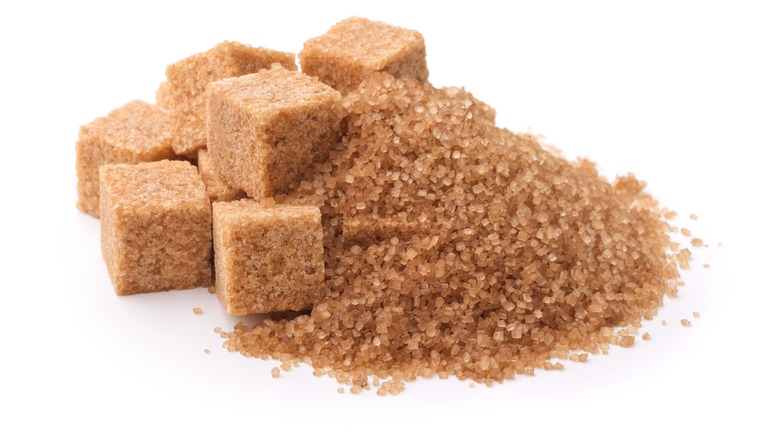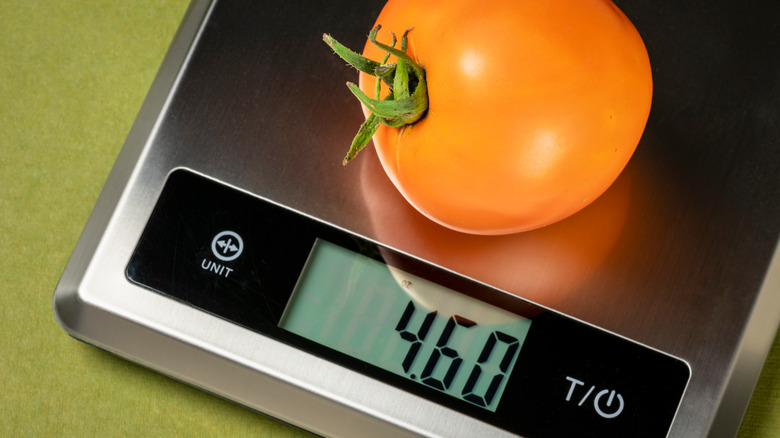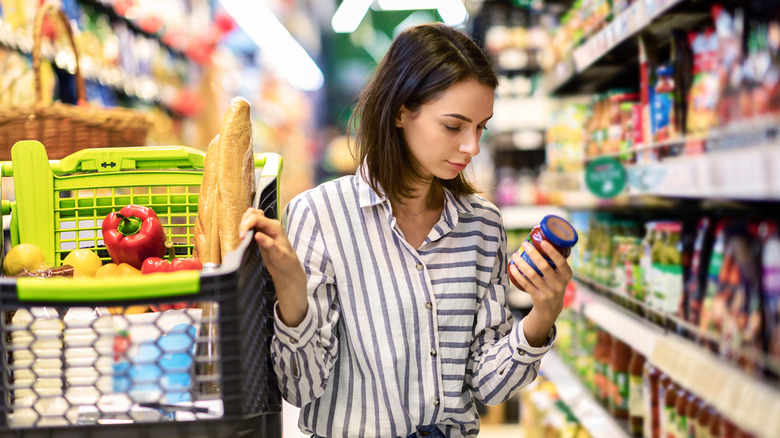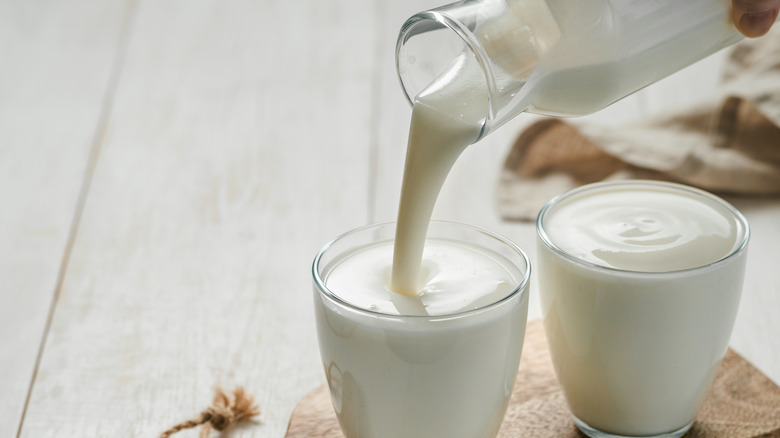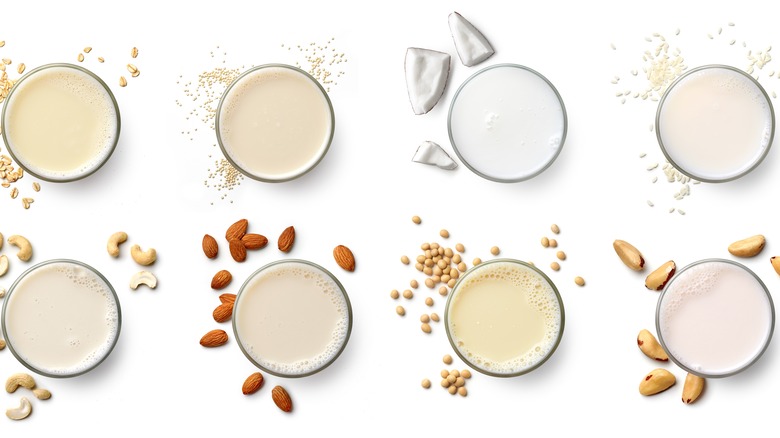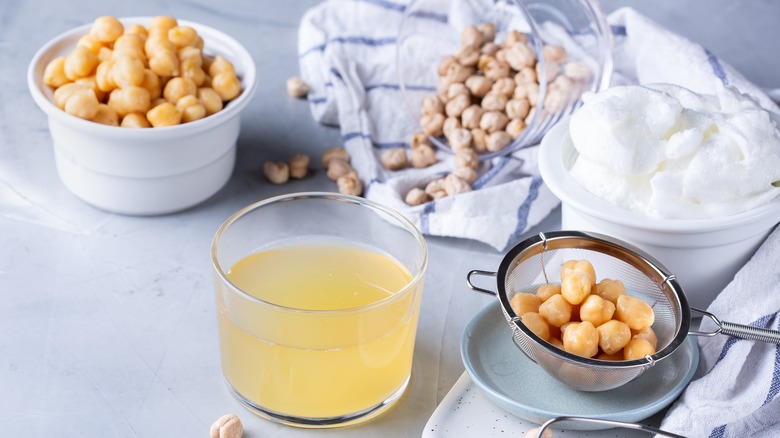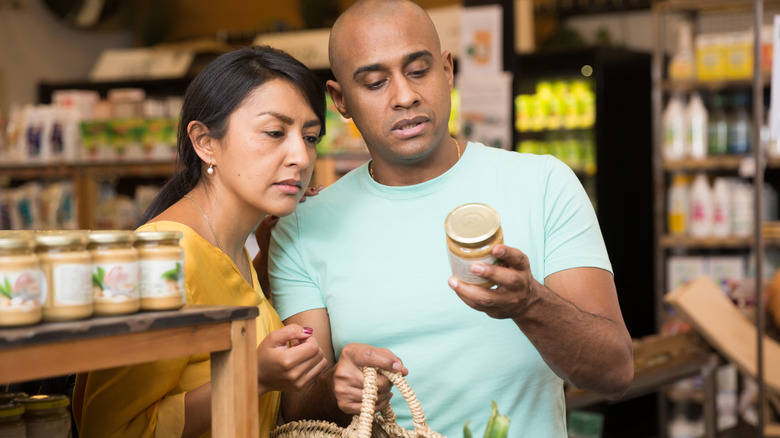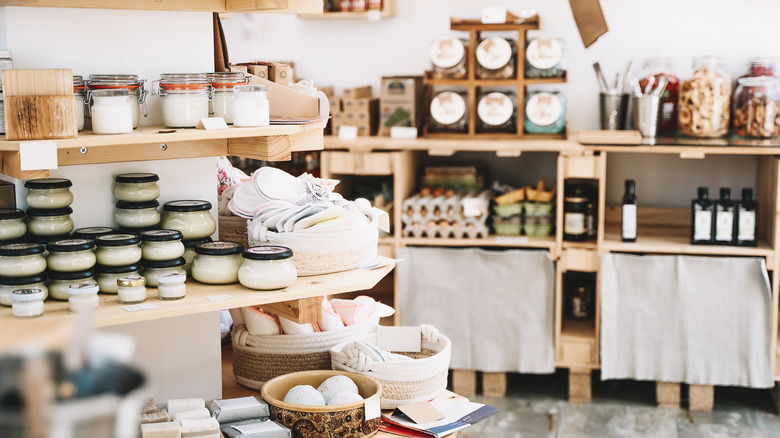12 Tricks For The Vegan Baker
We may receive a commission on purchases made from links.
Vegan baking has increased in popularity in recent years as people have become more invested in the environmental, ethical, and moral benefits of a plant-based diet. By definition, "vegan" baking abstains from utilizing animal products including eggs, dairy, and gelatin. Instead of using animal-based ingredients in baking, such as butter and heavy cream, a vegan baker can find appropriate substitutes that serve the same function in the recipe.
Realistically, vegan baking is not much different than non-vegan baking: It's just a matter of understanding the science of baking and making appropriate substitutions in recipes. While some recipes cannot be easily vegan-ized, like brown butter chocolate chip cookies, others can easily be replaced by using popularized vegan products like Country Crock Plant Butter and Bob's Red Mill Egg Replacer. Here are some of the best tips for adventuring into the world of plant-based baking, whether you're a seasoned home-cook or vegan baking novice.
Not all fats are treated equally
There are an array of non-dairy fat sources on the market including coconut oil, vegan butter, and plant oil. Not all these fat sources can be used in the same way when it comes to baking, though. Olive oil and avocado oil, for example, are typically used in stovetop cooking rather than baking because they are in a liquid form. Substituting liquid oil into a pie crust for more saturated fat would result in a puddle of oil (and an unhappy baker) when baked.
Before adding fat to a recipe, consider two important factors. The first is structure. Coconut oil is a semi-solid oil at room temperature like lard. Vegan butter, in comparison, has a firmer structure at room temperature and most closely resembles traditional dairy stick butter. In a scone recipe, the most logical dairy substitute would be vegan stick butter because it will keep its texture when cut into flour and result in a crumbly, yet decadent scone.
The other factor a baker must consider is the desired taste of the end product. One of the somewhat unconventional alternatives to butter is nut butter — typically peanut or almond butter. Peanut butter provides a source of saturated fats and protein but has a flavor profile that dominates the food more than a nuanced fat like vegan butter or coconut oil. For a chocolate peanut butter brownie recipe, that may be an acceptable flavor profile. But for an apple crisp? Not so much.
Skip the applesauce and banana for egg replacer
In its infancy, vegan baking popularized applesauce and mashed banana as egg replacers. Applesauce is commonly listed as a substitute for eggs because the pectin in the applesauce acts as a binder and traps oxygen — resulting in a soft, moist structure. Bananas also provide a moist alternative to eggs in baking, but they can alter the taste of the finished baked good.
Flax eggs (also called "fleggs") can offer a more neutral taste along with protein, essential fatty acids, and fiber according to Healthline. To make flax eggs at home, combine 3 tablespoons of finely ground flax seed (made in a food processor) with 1 tablespoon of water. Allow the mix to sit for 10 minutes before mixing it into the batter. Chia seeds can also act as a substitute for eggs. Bob's Red Mill recommends adding 1 tablespoon of chia seeds to 3 tablespoons of boiling water and allowing the mixture to sit for five minutes.
For individuals looking to skip the seed, egg, and fruit substitutes altogether, there is Bob's Red Mill Egg Replacer. To prepare, simply mix 2 tablespoons of water with 1 tablespoon of powder and stir. The binding starches, including potato starch, tapioca powder, baking soda, and psyllium husk, help keep the baked goods moist and structured. This mix is easy to use and friendly for a variety of dietary needs.
Utilize beet, coconut, or organic sugar
The ethical question of sugar being entirely vegan is a hot topic for the plant-based community. And if you're racking your brain wondering how sugar could not be vegan, you wouldn't be the only one. Make It Dairy Free notes that there are three main types of sugar in conventional food manufacturing: sugarcane, beet sugar, and coconut sugar. In the United States, some (not all) sugarcane is filtered with bone char to whiten its appearance. Bone char is made from cattle or pig bones, and although it does not remain in the sugar itself after the refining process, some vegans will refuse to use white or brown sugar unless it is certified as a vegan product, certified organic (which prohibits bone char as a filtration tool), or made from beets or coconut (which do not use bone char).
The simple way around this ethical conundrum is to opt for organic sugar, beet sugar, or coconut sugar. Organic brown sugar (white sugar that contains molasses) or organic powdered sugar will not contain bone char.
Use a scale rather than measuring cups
Using a digital scale should be a standard practice in baking regardless of style. However, vegan baking is especially dependent on correct ratios.
Baking using a scale can reduce the inconsistencies in measuring style. While home bakers will level off measurement tools, some others will leave heaps in the scoop (and though that's not the proper way to do it, some people just don't realize it). The result is an inconsistent texture, moisture, and/or flavor. At $10 (prices may vary depending on location), this kitchen scale from Amazon will reduce inconsistencies in your baking and allow you to recreate the same recipes bake after bake.
There are more benefits to a kitchen scale than just consistency. This article on digital scales recommends using a scale to speed up the measuring process and reduce the dishwashing load after the bake is finished. It also prevents the rookie mistake of confusing teaspoons for tablespoons (we've all been there).
Read the allergen labels
Vegan baking is not strictly for plant-based eaters; individuals with dairy or egg allergies can benefit from learning how to apply vegan cooking techniques to their culinary toolkit. When baking for people with allergies or those who are strictly vegan, it is critical to read food labels before purchasing your items. Dark chocolate, for example, is commonly thought to be vegan. However, a 2020 study by the U.S. Food and Drug Administration found that many dark chocolate products sampled contained dangerous levels of milk contamination even though it was being marketed as "dairy-free." The reason for this was mostly due to dark chocolate being produced on the same equipment as milk chocolate.
The best practice to ensure minimal cross-contact with allergens like egg and dairy is to read the label. "Contains" refers to a product that is made up of an allergen. Advisory statements, such as "made in a facility that produces allergen" provide a warning to those who may have severe contact allergies. If you plan on baking goods for someone else, it's best to ask them if they have any allergies (and the severity of those allergies) before baking.
Make buttermilk with vinegar and plant-based milk
Some bread and biscuit recipes may call for curdled milk made using plant milk and acid. The acidic agent in traditional buttermilk interacts with baking soda to produce a higher, fluffier rise. The interaction also breaks down gluten, the protein that gives structure to bread and floured baked goods. The result is a crumblier texture like you get in scones.
Vegan bakers can use apple cider, lemon juice, or distilled white vinegar with plant-based milk to mimic the same interaction as buttermilk. Loving It Vegan recommends stirring one 1 tablespoon of lemon juice with 1 cup of soy milk and letting it sit for a minute until it curdles. Our Plant-Based World further suggests using high-protein plant milk, such as soy, hemp, or oat milk, to produce consistent curdling. Low-protein milk, such as cashew milk, coconut milk, and rice milk, do not produce consistent enough curdling when combined with an acid.
Use unsweetened plant milk
Unlike dairy milk, the modern consumer has dozens of choices for brands that make many types of plant-based milk. A 2021 article by Food Manufacturing notes that soy milk remains the most popular plant milk globally, although coconut milk is one of the most rapidly growing types of plant milk. Consumers can also purchase oat milk, almond milk, and hemp milk.
When it comes to baking, flavor matters. Therefore, an experienced vegan baker will choose an unsweetened, neutral-tasting milk that is conducive to the texture needed in the baked good. Coconut milk is one of the more pungent non-dairy replacements. If a baker wanted a more nuanced flavor, one plant-based alternative that provides a comparable substitute is almond milk. Almond milk's versatility allows for it to be used for both savory and sweet dishes. Similarly, oat milk provides a sweet, creamy undertone for scones, muffins, or pastries.
Don't fear the unique
Aquafaba isn't a science experiment gone wrong — it's the starchy leftover liquid from a can of chickpeas or canned beans. Aquafaba can be used as a vegan meringue replacement as it can be whipped and turned into frosting, icing, or batter, or can be used as an egg white replacement.
Another unusual vegan baking ingredient? Avocados. Avocados are a rich, nuanced source of fat in baked goods. Chocolate Covered Katie recommends using avocados to make a chocolate cake, while chef Carla Hall recommends adding avocados to make decadent, fibrous brownies.
Dates are a common fruit found in vegan cooking. Their high sugar and fiber content are applicable to many vegan baked goods including The Baking Explorer's vegan millionaire shortbread. This recipe includes a crisp biscuit layer topped with maple syrup and date caramel and finished with melted dark chocolate. Medjool dates can also be the spotlight in a sweet potato chocolate brownie recipe made with raw hazelnuts, almond butter, almond flour, and sweet potatoes.
Shop items that are accidentally vegan
As a label, "vegan" foods are often seen as more expensive and exclusive than their non-vegan counterparts. The Vegan Society suggests that a novel consumer market combined with social media influencers touting "health foods" creates a significant disparity in the price of vegan and non-vegan foods. In reality, the most expensive vegan foods are often the ones that are organic, heavily processed, or located in the "natural foods" section of a grocery store.
Next time you enter a grocery store for plant-based ingredients, go directly to the food aisles rather than the specialty grocery section. You're likely to find items that aren't marketed as vegan but do not list any animal products on the label. One example is Trader Joe's semi-sweet chocolate chips. These accidentally dairy-free baking chips are $1.99 for a 12oz bag. In comparison, a 10oz bag of Enjoy Life semi-sweet mini chocolate chips rings in at $5.99. Saving money while eating vegan is often just a matter of reading the label.
Share ingredients with friends and buy in bulk
Some vegan recipes utilize unique ingredients like arrowroot starch, psyllium husk, and xanthan gum in minimal quantities. For frequent bakers (especially those who bake gluten-free), purchasing bags of these goods may come in handy. But for the broad spectrum of bakers, sharing small quantities of these ingredients is much more financially sustainable.
Another alternative to purchasing small quantities of ingredients is to shop in the bulk section of a natural foods grocery store. According to GreenMatters, shopping in the bulk section allows individuals to bring their own containers and purchase only the amount of food that they need for a given period. This in turn reduces food and plastic waste. To shop in a bulk section, bring clean containers (like Mason jars) to the section and record the tare weight using a scale. The tare weight is the weight of the container without anything in it. After filling the container with the desired quantity, record the finished weight at the register. Saving money and plastic waste? Count us in.
Pick a highly-reviewed recipe
This tip goes out to all bakers and chefs, regardless of your specialty. If you're baking chocolate chip cookies, do you want to scroll through recipes to find the one with the lowest rating, scant measurements, and overly generalized directions? Or do you want a recipe that tells you exact temperatures and times, with over a hundred reviews from folks who have tried the same recipe at home?
Other important recipe red flags include recipes with tons of comments and likes — but with very little substance. Comments like "I love this!" and "great job!" provide little feedback for folks looking to recreate a recipe. Likewise, comments that list a plethora of substitutions rarely review the recipe as its creator intended it.
In examining recipes, consider the credibility of the outlet or source. If the recipe is coming from an outlet that hires professional food scientists and recipe developers, it is likely more of a credible source for recipes than a random food blog with two posts and a picture of a dog (no shade to the dog).
Not all substitutions are 1:1
It would be unreasonable to expect the average home baker to have access to every ingredient for every recipe every time. This is where substitutions can be an invaluable component in baking.
Substitutions in baking come with a caveat: Not all ingredients can be substituted for one another interchangeably. When new ingredients are added, the physical and chemical properties of the finished product are changed. Sometimes, these changes are for the better — like substituting dark chocolate for milk chocolate in a recipe. But substituting and changing a recipe can also negatively impact the flavors, textures, and crumbliness of your favorite baked goods.
One popular ingredient in vegan cooking is arrowroot starch. Bake It With Love says arrowroot is used as a thickening agent in stews, sauces, and gravies. Arrowroot powder can be substituted with a variety of agents including all-purpose flour, cornstarch, and sweet rice flour. Sweet rice flour has a higher starch content and will make the thickening mixture more cloudy when combined with water. As a result, bakers should use a 1-to-½ ratio of arrowroot starch to sweet rice flour in a recipe. In contrast, tapioca starch, flour, and cornstarch follow a 1-to-1 ratio.

